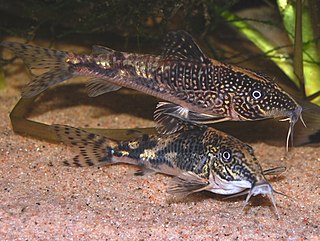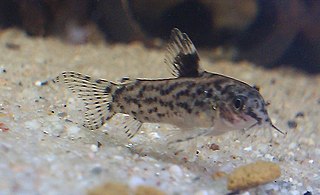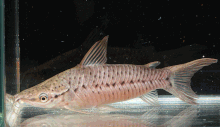
Loricariidae is the largest family of catfish, with 92 genera and just over 680 species. Loricariids originate from freshwater habitats of Costa Rica, Panama, and tropical and subtropical South America. These fish are noted for the bony plates covering their bodies and their suckermouths. Several genera are sold as "plecos", notably the suckermouth catfish, Hypostomus plecostomus, and are popular as aquarium fish.

Corydoras is a genus of freshwater catfish in the family Callichthyidae and subfamily Corydoradinae. The species usually have more restricted areas of endemism than other callichthyids, but the area of distribution of the entire genus almost equals the area of distribution of the family, except for Panama where Corydoras is not present. Corydoras species are distributed in South America where they can be found from the east of the Andes to the Atlantic coast, from Trinidad to the Río de la Plata drainage in northern Argentina. Species assigned to Corydoras display a broad diversity of body shapes and coloration. Corydoras are small fish, ranging from 2.5 to 12 cm in SL., and are protected from predators by their body armor and by their sharp, typically venomous spines.

Otocinclus is a genus of catfish in the family Loricariidae native to South America, commonly known as "dwarf suckers" or "otos". This genus, like other loricariids, is characterized by rows of armour plating covering the body, as well as the underslung suckermouth. They are generally small in size; O. tapirape is the smallest of the species (2.4 cm), while O. flexilis is the biggest (5.5 cm). These species have adaptations that allow them to breathe air. A duct forms at the junction between the esophagus and the stomach and expands into an enlarged, ring-like diverticulum, characteristic of this genus, which allows air-breathing. Otocinclus are popular aquarium fish, and they are often purchased as algae eaters. It is difficult to breed them in captivity, and only wild caught Otocinclus are available to hobbyists. This genus is widely distributed east of the Andes of South America, throughout the lowlands from northern Venezuela to northern Argentina, but are generally absent from the Amazon and the Orinoco lowlands.

The bronze corydoras, also known as the green corydoras, bronze catfish, lightspot corydoras or wavy catfish, is a species of freshwater fish in the armored catfish family, Callichthyidae, often kept as an aquarium fish. It is widely distributed in South America on the eastern side of the Andes, from Colombia and Trinidad to the Río de la Plata basin; however, as presently defined it is a species complex and a taxonomic review is necessary. It was originally described as Hoplosoma aeneum by Theodore Gill in 1858 and has historically also been referred to as Callichthys aeneus.

Aspidoras is a genus of catfishes of the family Callichthyidae from Brazil.

The banded corydoras or bearded catfish is a subtropical freshwater fish belonging to the subfamily Corydoradinae of the family Callichthyidae. It originates in coastal drainages in South America from Rio de Janeiro to Santa Catarina, Brazil.
The Guapore corydoras is a tropical freshwater fish belonging to the subfamily Corydoradinae of the family Callichthyidae. It originates in inland waters in South America, and is found in the Guaporé River basin in Brazil. It is named for the river to which it is native.
Britski's catfish is a tropical freshwater fish belonging to the subfamily Corydoradinae of the family Callichthyidae native to South America where it is found in the upper Paraguay River basin in Brazil. This species was formerly classified as Brochis britskii.

The hog-nosed catfish is a tropical freshwater fish belonging to the Corydoradinae sub-family of the family Callichthyidae. It is native to South America, and is found in the western Amazon basin in Ecuador and Peru. This species is traditionally placed in Brochis but the genus is a synonym of Corydoras. FishBase continues to recognize Brochis as a valid genus.

The sixray corydoras or false corydoras is a tropical freshwater fish belonging to the Corydoradinae sub-family of the family Callichthyidae. It originates in inland waters in South America, and is found in the upper Araguaia River basin in Brazil.

Callichthys is a small genus of freshwater catfish in the Callichthyinae subfamily of the armored catfish family, and consists of 4 species from South America. The genus Callichthys is distributed in most freshwater drainages of South America.

Callichthys callichthys, the cascarudo, armored catfish, bubblenest catfish, hassar, or mailed catfish, is a subtropical freshwater fish belonging to the subfamily Callichthyinae of the family Callichthyidae.

Hoplosternum is a small genus of freshwater catfish in the Callichthyinae subfamily of the armored catfish family.

Megalechis is a small genus of freshwater catfish in the Callichthyinae subfamily of the armored catfish family.
Callichthys fabricioi is a tropical freshwater fish belonging to the Callichthyinae sub-family of the family Callichthyidae. The fish will grow in length up to 12.5 centimetres (5 in) SL. C. fabricioi is found in the trans-Andean upper Cauca River in the Magdalena River basin of Colombia. Although described in 1999, two other cogener fish have since been discovered.
Callichthys serralabium is a tropical freshwater fish belonging to the Callichthyinae sub-family of the family Callichthyidae.

Hoplosternum littorale is a species of catfish belonging to the Callichthyinae subfamily of the family Callichthyidae. It is known as tamuatá in Brazil, atipa in French Guiana, hassa in Guyana, kwi kwi in Suriname, cascadu or cascadura in Trinidad and Tobago, and busco or currito in Venezuela.

Scleromystax is a genus of fish in the family Callichthyidae endemic to small tributaries from several coastal river basins draining the southern and southeastern regions in Brazil. Most of the species of Scleromystax are highly sexually dimorphic; males have developed odontodes inserted in fleshy papillae on the preopercular-opercular region and the dorsal and pectoral fins are 2–3 times as long as those of females. S. salmacis is an exception, as its sexually dimorphic features are subtle and non-remarkable.
Corydoras fulleri, formerly identified as C116/115, is a tropical freshwater fish belonging to the subfamily Corydoradinae of the family Callichthyidae native to South America where it is found in two tributaries of the río Manuripe and a tributary of the río Madre de Dios, rio Madeira basin, Peru. It lives in a tropical climate in water with a temperature range of 22–26 °C (72–79 °F).
Corydoras robineae the banner-tail corydoras is a tropical freshwater fish belonging to the Corydoradinae sub-family of the family Callichthyidae. It originates in inland waters in South America. Corydoras robineae is restricted to the Upper Negro River basin.













